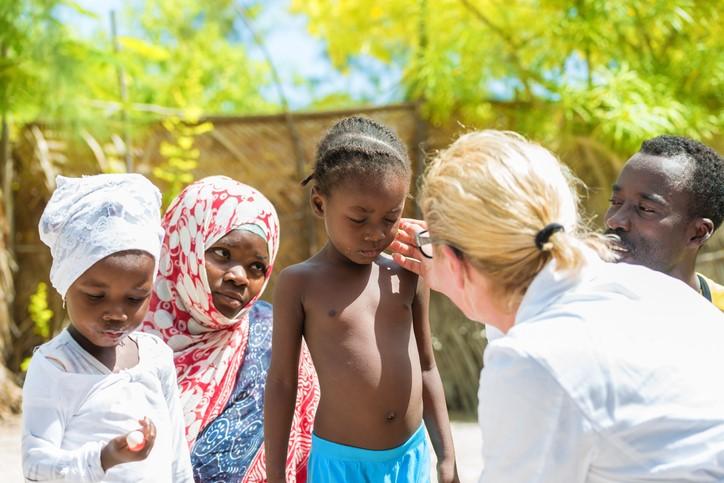New follow-up data today in the New England Journal of Medicine (NEJM) provide additional evidence that mass distribution of azithromycin could be a strategy for reducing childhood mortality in parts of sub-Saharan Africa.
But concerns about antibiotic resistance remain. In fact, a separate analysis published today as a letter in the NEJM notes rising drug resistance among children from the original 2018 study.
The data in the new mass-distribution study come from a follow-up to a randomized clinical trial that found that twice-a-year doses of azithromycin over 2 years to healthy children under the age of 5 was associated with a 14% reduction in childhood mortality in rural communities in Niger, Tanzania, and Malawi when compared with communities in which children received a placebo.
Those results, published last year, surprised the researchers but also raised concern among some infectious disease and antibiotic resistance experts, who questioned whether mass distribution of azithromycin could promote antibiotic resistance and reduce the effectiveness of the drug.
In the follow-up study, the same team of researchers went back to communities in Niger, which had seen the biggest reductions in childhood mortality in the first study—known as the MORDOR I (Macrolides Oraux pour Réduire les Décès avec un Oeil sur la Résistance) trial—to see what would happen if twice-a-year azithromycin was given both to the communities that had originally received it and to those that had originally received a placebo. They say the results support the findings of the original study.
"It gives us confidence in the original MORDOR results and bolsters the case that mass azithromycin distributions might be used as a public health intervention to reduce childhood mortality," study co-author and University of California-San Francisco ophthalmology professor Jeremy Keenan, MD, MPH, told CIDRAP News.
Effect doesn't wane
In MORDOR II, Keenan and his colleagues returned to 594 communities in Niger to test a hypothesis—whether a third year of twice-yearly oral doses of azithromycin, in the communities that received it the previous 2 years, would have a reduced effect on mortality.
If resistance to azithromycin had built up in the children who'd received it for 2 years, they theorized, the observed beneficial effect of the drug might wane. In MORDOR I, childhood mortality rates fell by 18% in azithromycin-treated communities in Niger.
To test this hypothesis, they compared the community-level, all-cause mortality rate in the communities receiving a third year of azithromycin to the rate in communities receiving it for the first time.
They found that the childhood mortality rate was similar in the two groups—24.0 deaths per 1,000 person-years (95% confidence interval [CI], 22.1 to 26.3) in the communities receiving their first year of azithromycin doses, and 23.3 deaths per 1,000 person-years (95% CI, 21.4 to 25.5) in the communities receiving a third year of azithromycin doses. Furthermore, in communities that had originally received a placebo in the original study, azithromycin was associated with a 13.3% reduction in childhood mortality (95% CI, 5.8 to 20.2, P = 0.007).
In the communities that received azithromycin in MORDOR I, the difference in mortality between the third year and the first 2 years was not significant (−3.6%; 95% CI, −12.3% to 4.5%, P = 0.50).
"One important result is that we did not find evidence that the effect waned over time," Keenan explained. "If we had found evidence of a waning effect, this would have lowered enthusiasm for mass azithromycin distributions as a strategy for reducing childhood mortality. Another important result is that the communities originally receiving placebo experienced a reduction in childhood mortality once given azithromycin."
Keenan noted that this is still an observational result and should be interpreted with caution, and that it remains unclear how azithromycin might be preventing childhood deaths. "Thus far our general sense is that azithromycin may work better in places with the highest childhood mortality, and these places have a very high burden of infectious illnesses, so we think azithromycin very likely is treating a multitude of infections that might ultimately have caused a death," he said.
Other theories include a benefit to childhood growth, a change in gut microbiota, or an anti-inflammatory effect. Keenan said papers addressing this question are forthcoming.
Concerns about resistance remain
But despite the results, questions and concerns about the impact of such a strategy on antibiotic resistance still linger. In the NEJM letter today, Keenan and his colleagues report the results of an analysis of nasopharyngeal and rectal bacteria from children in Niger who were involved in MORDOR I. The analysis compared the samples from children who had received azithromycin with those who had received placebo.
The results showed that the proportion of resistance to macrolides (the class of antibiotics that includes azithromycin) in nasopharyngeal Streptococcus pneumoniae was 12.3% in the communities receiving azithromycin (95% CI, 5.7% to 20.0%) and 2.9% in those receiving placebo (95% CI, 0% to 6.1%). Determinants of resistance to macrolides were also more prevalent in the intestinal flora of the children who received azithromycin. There was no evidence of increased resistance to other antibiotics.
These results weren't surprising, as studies in communities that have received mass azithromycin to reduce the prevalence of trachoma—a bacterial eye infection that is the leading infectious cause of blindness worldwide—have also observed the development of resistance. Mass azithromycin distribution is one of the strategies recommended by the World Health Organization to eliminate trachoma in areas of the world where the disease is endemic.
Keenan said that while it's unclear what the clinical impact of this resistance will be, it can't be ignored.
"Monitoring for antimicrobial resistance is crucial, and the implementation of any mass azithromycin distribution program must take resistance into account," he said. "We should continue looking for potential antimicrobial resistance and, perhaps more importantly, the clinical impact of antimicrobial resistance, so we can better weigh the pros and cons of mass antibiotics."
He also suggested that a mass azithromycin distribution program targeted to children under 5 would dispense a much lower volume of antibiotics in the community than trachoma prevention programs, which distribute the drug to children over the age of 6 months, and may result in less resistance. Keenan and his colleagues note that the MORDOR studies distributed approximately a third as many doses of azithromycin per community per year as would a trachoma-prevention program.
Optimizing use
Naor Bar-Zeev, MBBS, PhD, MPH, a pediatric infectious diseases physician and epidemiologist at Johns Hopkins Bloomberg School of Public Health who was not involved in the study, says the MORDOR studies are important and compelling, but leave some questions unanswered.
One question, raised by Bar-Zeev and co-author William Moss, MD, MPH, in an accompanying commentary, is whether the observed effect on mortality can be further replicated. They note that a 2009 study found that mass distribution of azithromycin for trachoma in Ethiopia halved all-cause mortality in children ages 1 to 9, while a study on the addition of azithromycin to an anti-malaria regimen in Burkina Faso and Mali found more deaths in the group of children treated with the drug. They also suggest a longer-term analysis of the MORDOR results could find that the effect might diminish over time.
"We're still not entirely clear on how best to optimize the use of azithromycin, or what its actual true, expected impact might be," Bar-Zeev said in an interview. "We need to be enthusiastically cautious."
After the results of MORDOR I were published last year, some infectious disease and antibiotic resistance experts expressed concern about the ethical implications of mass distribution of azithromycin, given the emergence of antibiotic resistance as a global health crisis. While Bar-Zeev agrees that further monitoring for resistance is necessary, he argues that the potential benefit to childhood mortality, especially in countries like Niger, can't be overlooked.
"Even though at the moment everybody sees antimicrobial resistance as a global threat, childhood mortality, to me, is also a global threat," he said.
Bar-Zeev says more studies on mass distribution of azithromycin from the MORDOR group and others are necessary and will help answer questions about how to best use the drug. In fact, he's currently leading a study on whether the use of azithromycin in children who have moderate to severe diarrhea reduces mortality and stunting.
"The more we understand, the more we'll know how to tailor use of this intervention, knowing that it has some risks," he said.
See also:
Jun 6 N Engl J Med study
Jun 6 N Engl J Med letter
Jun 6 N Engl J Med commentary
May 2, 2018, CIDRAP News story, "African study on pre-emptive antibiotics in kids spurs resistance debate"























